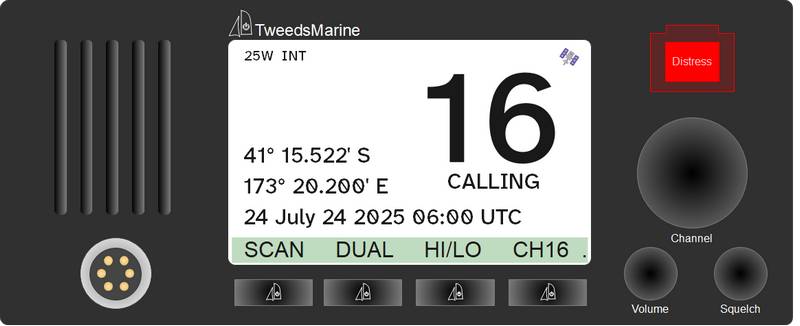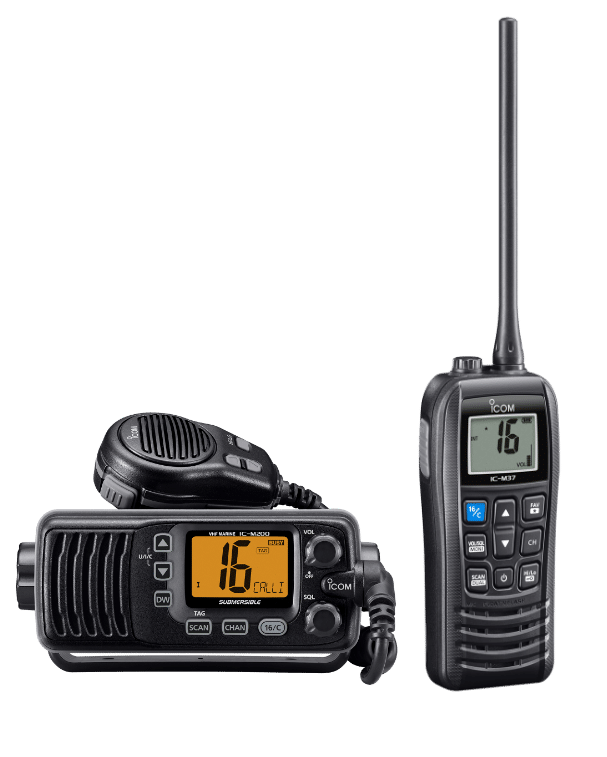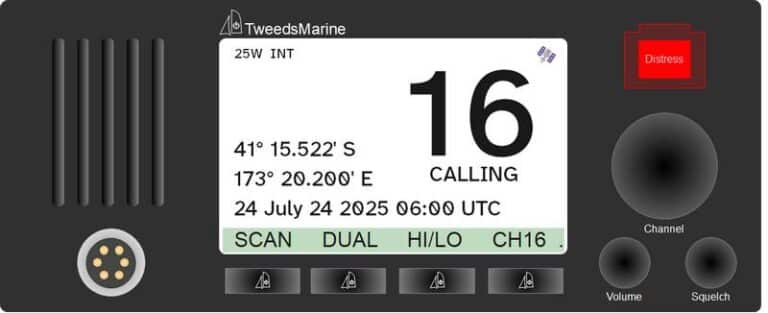How Does Marine VHF Radio Work?
If you’re new to boating, you might have heard about marine VHF radios but wondered, “What exactly is it? How does it work? And why do I need one on my boat?” Don’t worry — you’re not alone! Marine VHF radios are a vital piece of safety and communication equipment for anyone heading out on the water, and understanding the basics will help you feel confident and prepared.
In this article, we’ll break down the fundamentals of marine VHF radio, how it works, and why it’s so important for sailors of all levels. Let’s dive into understanding VHF marine radio basics!

What Is Marine VHF Radio?
Marine VHF (Very High Frequency) radio is a type of two-way radio used by boats and coastal stations to communicate over short to medium distances (10s of metres to 20 nautical Miles). It operates on specific frequencies reserved for maritime use, allowing vessels to communicate with each other, contact coast stations, and access emergency services as needed.
Think of it as your boat’s voice on the water — a lifeline for navigation, safety, and staying connected.
Note that the frequencies used are not identical worldwide, so check that your radio is set to the correct set of frequencies. Usually “Int” for most of the planet or “USA” for the USA
The Basics of Radio and Propagation
This is a complex topic, and therefore, I will overlook certain advanced details in this discussion, but none of them significantly alter the outcomes. Antenna selection and propagation are huge subjects, but a basic understanding is required to get the best from your boat’s radio. Note that the drawings are not to scale 😉
At its core, a VHF radio sends and receives radio waves — invisible electromagnetic signals that travel through the air, or space. Marine VHF radios operate in the 156 to 174 MHz frequency range, which is ideal for line-of-sight communication.
Hertz
Hertz is a measure of frequency. One Hertz is one cycle per second. Mega is the SI unit for 1,000,000. Marine VHF channel 16 is on the frequency of 156,800,000 Hertz, which is a bit of a mouthful; instead, we use 156.8MHz, or just Channel 16.
Line-of-Sight
What does line-of-sight mean? It means the radio waves travel straight and don’t bend much around obstacles or over the horizon. So, the higher your antenna is mounted, the farther your signal can reach. On the water, this usually means you can communicate up to about 10 to 30 nautical miles, depending on antenna height and weather conditions.
Antenna height is the overriding factor affecting the range that a VHF signal can reach. The transmitted power available on all marine radios is more than sufficient to reach the radio horizon in ideal conditions. Typically fixed fixed-mount radios provide 25 Watts on high power and 1W on low, handheld radios around 5 Watts on high and 1 Watts on low. The extra power available is useful in poor conditions and non-ideal antenna orientations (think of rolling boats, heeling sailing vessels, less-than-perfect antenna placement, etc.).
I have made this calculator script to illustrate this. Move the slider to select your antenna height and observe the values in the “radio horizon” column change. The rows in the table give some fixed antenna heights ranging from 2m (somebody standing with a handheld radio), to a coast station antenna 500m up a hill. The distance over which two stations can communicate is a function of their combined height.
Boat Antenna Radio Range Calculator
Frequency: 156.8 MHz
Estimated Workable Range
Your antenna to distant antenna (nautical miles)
| Receiving Antenna Height (m) | Workable Range |
|---|
Estimated Maximum Radio Range by Power Level
Over an unobstructed path i.e. boat to satellite.
| Power Level | Transmit Power (W) | Max Range (nautical miles) |
|---|---|---|
| Low Power | 1 W | – |
| Hand Held | 5 W | – |
| High Power | 25 W | – |
If you know what type of coax is used on your radio installation, you can change that too.
The point that I want you to notice here is that the distance to the radio horizon changes with antenna height, and changing the type of coax has no effect on the range you will achieve, and the reason is illustrated in the bottom table where you can see the estimated range attainable over a clear path for a given power output.
Coax
Coax, short for coaxial cable, describes the construction of the cable used to connect the radio to the antenna. It consists of a wire core, a layer of insulation, another layer of wire (usually a braid) and finally an outer layer of insulation.
The quality of your coax cable doesn’t make much difference to the range that you will be able to transmit, but it makes a lot of difference to the ability of your radio to receive weak signals. Always use the best type and quality coax that you can afford. The bottom line with coax is that you should only buy from a reputable dealer with the advice of somebody who knows what they are talking about!
Given line of sight, even a one-watt transmission is capable of reaching 300 nautical Miles or more, even with these basic low-gain antennas; this is the reason that a one-watt AIS class B transmission can be picked up by an AIS satellite.
Antenna Gain
Antenna gain is a measure of how much the antenna concentrates the signal in a particular direction; an antenna can’t amplify a signal, it can only concentrate the power in a certain direction, visualise it like a flashlight’s reflector concentrating the light.
Gain is usually quoted in dBi (decibels relative to an isotropic antenna), but much advertising blurb leaves off the ‘i’. The decibel range is logarithmic; therefore, 3dB is double whatever 0dB was, and 6dB is four times whatever 0dB was. A standard short marine whip antenna has a gain of around 3dBi, give or take quite a bit!
Reading the preceding paragraph, you might think that bigger (higher gain) antennas mean better performance. If you were setting up a fixed radio link on land, that would be true, but we are dealing with mobile antennas on a rolling, pitching, heaving platform.
As a general rule, for a mobile marine antenna, we want our antenna to transmit the signal (radiate) equally well in all directions.
Vertical whip antennas radiate in a pattern shaped like a doughnut. The higher the gain, the thinner and wider the doughnut becomes.
Effect of Gain on Radiation Pattern
- Gain increases antenna focus, resulting in a narrower vertical beamwidth.
- Higher gain antennas produce a sharper and flatter radiation pattern vertically.
- This concentrates energy more horizontally but reduces coverage above and below the horizontal plane.
Impact of Boat Heeling on Radio Link
- When a boat heels, the antenna tilts.
- Low-gain antennas with wide vertical beamwidth maintain effective coverage despite tilting.
- High-gain antennas with narrow vertical beamwidth lose coverage towards the horizon when tilted.
- This misalignment causes signal degradation and weaker radio links.
| Aspect | Low-Gain Antenna | High Gain Antenna |
|---|---|---|
| Vertical Beamwidth | Wide (more vertical coverage) | Narrow (sharper, flatter pattern) |
| Radiation Pattern | More forgiving to tilt | Sensitive to tilt |
| Performance When Heeled | Maintains better link | Link degrades due to misalignment |
How does this help you choose a suitable antenna for your boat?
- If you have a monohull sailing boat, you want a low-gain antenna with a nice, fat vertical radiation pattern.
- If you have a small powerboat that may be rolling around a lot, you want a low-gain antenna with a nice, fat vertical radiation pattern.
- If you have a catamaran or larger, stable, powerboat, you can choose a higher gain antenna.
In all cases, mount the antenna as high as possible using the best quality coax cable that you can afford.
Basic Parts of a Marine VHF Radio
A typical marine VHF radio has a few key components:
- Transceiver: The main unit that sends and receives signals.
- Microphone: Used to speak and transmit your voice.
- Speaker: Plays incoming messages.
- Antenna: Mounted outside the boat, it broadcasts and receives radio waves.
- Display and controls: For selecting channels, adjusting volume, and other settings.

Some radios are handheld and portable, great for small boats or as a backup. Others are fixed-mount units installed on larger vessels, often integrated with other navigation equipment. These are both Icom units.
Where the Radio Fits Into Your Boat’s Electrical System
Marine VHF radios typically run on 12-volt DC power from your boat’s battery system. They are wired into the electrical system with a fuse or circuit breaker for safety.
I recommend that your radio be part of your “always on” power supply. This is a supply that does not pass through the main battery isolator, which supplies bilge alarms and pumps, etc.. This way, in an emergency, anybody on your boat only has to switch the radio on and use it without having to hunt for an isolator switch. There may be emergencies where the main battery has to be isolated, such as a fire, but you need the radio.
Because the radio is a critical safety device, it’s important to ensure it has a reliable power source. Many sailors also keep a backup handheld radio with fresh batteries in case of electrical failure.
Proper installation and wiring help prevent interference and ensure your radio works when you need it most. For more information, see this article on reliable power and others in the same series.
Coast Stations and How They Help
Coast stations are shore-based radio stations operated by maritime authorities or private companies. They monitor marine VHF channels, provide weather updates, navigational warnings, and relay distress calls. Ports and harbours often have a port control station providing traffic information to vessels entering and exiting. Many areas have a local coast station assisting mariners as a social service. For example, my local station is Marlborough-Nelson Marine Radio
When you’re out sailing, you can contact a coast station for assistance, information, or to report emergencies.
How Emergency Services Are Contacted
One of the most important reasons to have a marine VHF radio is to call for help in an emergency. Channel 16 is the international distress, safety, and calling channel. It’s monitored continuously by coast stations and many vessels.
If you find yourself in trouble — like a man overboard, engine failure, or medical emergency — you use Channel 16 to send a MAYDAY call. This is the recognised distress signal that alerts everyone nearby that you need immediate assistance.
There’s also PAN-PAN, which signals an urgent situation that is not immediately life-threatening, and SECURITE, which is used for safety messages such as navigational warnings.
Knowing how and when to use these calls can save lives.
Basic Radio Procedure and Etiquette
Using a marine VHF radio isn’t like chatting on a cell phone. There are some simple rules and etiquette to follow to keep communication clear and respectful:
- Select the correct channel: Select channel 16 or another local calling channel, make your initial call, then change to a ‘working’ channel.
- Listen before you talk: Always monitor the channel before transmitting to avoid interrupting others.
- Keep it brief and clear: Use short, simple sentences. Speak slowly and clearly.
- Identify who you are calling: by their boat name or station name, and callsign.
- Identify yourself: With your boat’s name and call sign.
- Use proper call signs: This helps others know who you are.
- Avoid unnecessary chatter: Keep Channel 16 free for emergencies and important calls.
- Use the phonetic alphabet: For clarity, especially with letters (e.g., Alpha, Bravo, Charlie).
Following these guidelines helps everyone stay safe and informed on the water.
Radio Safety: What You Need to Know
Using a marine VHF radio safely is just as important as knowing how it works. Here are some key safety tips:
- Always keep your radio turned on and monitor Channel 16 when underway. This way, you won’t miss important calls or emergency broadcasts.
- Use distress calls only in real emergencies. False alarms can waste resources and put others at risk.
- Make sure your radio and antenna are properly installed and waterproofed. Saltwater and moisture will damage equipment.
- Test your radio regularly. Check that it transmits and receives clearly.
- Have backup power. Keep spare batteries or a handheld radio on board.
- Know your local regulations and licensing requirements. In some places, you need a license to operate a marine VHF radio.
By following these safety practices, you’ll help keep yourself and others safe on the water.
A Few More Tips for Beginners
- Learn the common channels: Channel 16 for distress and calling, Channel 13 for bridge-to-bridge communication, and others used for ship-to-ship or ship-to-shore.
- Practice using your radio before you head out. Familiarity builds confidence.
- Keep a written list of important channels and procedures near your radio. This a requirement in many areas
- Respect other users and keep your transmissions professional.
- Take a recognised course similar to this one.
More information for New Zealand
Digital Selective Calling (DSC)
Marine VHF Radio DSC (Digital Selective Calling) is a communication system used in maritime environments to enhance safety and efficiency. It allows vessels to send automated distress alerts, routine calls, and safety messages digitally over VHF radio frequencies and to receive emergency and routine alerts.
DSC capable radios can be identified by their red distress calling button.
DSC is heavily used in some parts of the world, hardly at all in others. All commercial ships should have it. Having a DSC capable VHF radio gives you more options for calling other vessels, as even if they are not listening to your voice calls, a DSC call will sound an alarm and should be acknowledged in some way.
What it is used for:
- Sending distress alerts with precise location information automatically to nearby ships and rescue authorities.
- Making routine and safety calls without occupying voice channels.
- Establishing direct communication links between vessels or between vessels and coast stations.
How it works (briefly):
When a DSC call is initiated, the radio transmits a digital message containing the vessel’s identity (MMSI number), position (if connected to GPS), and the type of call (distress, urgency, safety, or routine). This message is sent on a dedicated DSC channel and can trigger alarms on receiving radios, prompting immediate attention or response. Voice communication can then follow on a separate VHF channel.
Why Every Sailor Should Have a Marine VHF Radio
Whether you’re sailing close to shore or venturing further out, a marine VHF radio is your best friend on the water. It connects you to help, information, and other boaters. It’s a simple device that can make a huge difference in safety and peace of mind. A radio has significant advantages over a cell phone in emergencies, the main one being that everybody can hear the transmissions, allowing them to offer assistance, relay messages, or even to stay out of the way.
I hope that you found the introduction to VHF marine radio basics useful. Let me know what you think and what you would like to see me cover in the comments.
Frequently asked Questions (FAQ)
What is the proper etiquette when using a marine VHF radio?
– Always listen on Channel 16 before transmitting.
– Keep transmissions brief, clear, and professional.
– Identify the station you are calling and yourself by boat name and callsign.
– Use the phonetic alphabet for clarity.
– Avoid unnecessary chatter to keep channels clear for emergencies.
What is a marine VHF radio and how does it work?
A marine VHF (Very High Frequency) radio is a two-way communication device used on boats to send and receive messages over short to medium distances, typically up to 20 nautical miles. It operates on specific maritime frequencies between 156 and 174 MHz, allowing vessels to communicate with each other, coast stations, and emergency services. The radio waves travel mostly in a straight line (line-of-sight), so antenna height greatly affects the communication range.
Why do I need a marine VHF radio on my boat?
Marine VHF radios are essential safety and communication tools for anyone on the water. They enable you to:
– Contact emergency services quickly using Channel 16 (distress channel).
– Communicate with other vessels and coast stations.
– Receive weather updates and navigational warnings.
– Coordinate with port authorities and marinas.
– Unlike cell phones, VHF radios broadcast openly, allowing nearby boats to hear distress calls and assist if needed.
What is the typical range of a marine VHF radio?
The effective range depends mainly on antenna height and power output. Typically, fixed-mount radios transmit at 25 watts and handheld radios at 5 watts. With a properly mounted antenna, you can expect communication ranges between 10 to 30 nautical miles under normal conditions. Higher antennas increase the radio horizon, extending the range.
What does “line-of-sight” mean in marine radio communication?
Line-of-sight means that VHF radio waves travel in straight lines and do not bend significantly over the horizon or around obstacles. Therefore, the higher your antenna is mounted, the farther your signal can reach because it can “see” over the curvature of the Earth and obstacles.
How does antenna height affect marine radio performance?
Antenna height is the most critical factor influencing your radio’s range. The higher the antenna, the greater the distance your signal can travel before being blocked by the horizon. For example, raising your antenna from 2 meters to 15 meters can significantly increase your communication range.
What types of antennas are best for marine VHF radios?
Low-gain vertical whip antennas with a wide vertical beamwidth are generally best for mobile marine use because they maintain good coverage even when the boat heels or rolls. High-gain antennas focus energy more horizontally, so they are only suitable for stable platforms such as larger vessels or multihulls.
What is Digital Selective Calling (DSC), and why is it important?
DSC is a digital communication system integrated into many marine VHF radios. It allows automated distress alerts with precise location data to be sent to nearby vessels and rescue authorities. DSC also enables routine and safety calls without occupying voice channels. Radios with DSC have a distinctive red distress button for emergency use.
How do I contact emergency services using a marine VHF radio?
In an emergency, use Channel 16 to send a MAYDAY call, the internationally recognised distress signal. This alerts all nearby vessels and coast stations that you need immediate assistance. For urgent but non-life-threatening situations, use PAN-PAN, and for safety messages, use SECURITE.
How should a marine VHF radio be powered on a boat?
Marine VHF radios usually run on 12V DC power from the boat’s battery system. It’s best to connect the radio to an “always on” power supply that remains active even if the main battery isolator is switched off, ensuring the radio is available in emergencies. Proper wiring with fuses or circuit breakers is essential for safety and reliability.
Where can I learn more about marine VHF radio operation and safety?
In New Zealand
– Maritime New Zealand: Maritime NZ VHF Radio
– Coastguard Boating Education: MSROC Course
Globally
– Contact your local boating training institutions and the coastguard or equivalent.
Do I need a license to operate a marine VHF radio?
Licensing requirements vary by country. Many regions require operators to hold a marine radio operator’s certificate or license. Check your local regulations before using a marine VHF radio.
Can I use a handheld marine VHF radio instead of a fixed unit?
Yes, handheld VHF radios are portable and useful as backups or for small boats. They typically have lower power (around 5 watts) and shorter range, but are convenient and essential for safety.
How do coaxial cables affect marine VHF radio performance?
Coaxial cables connect the radio to the antenna. While cable quality does not significantly affect transmission range, it impacts the radio’s ability to receive weak signals. Using high-quality coaxial cable reduces signal loss and improves reception.





